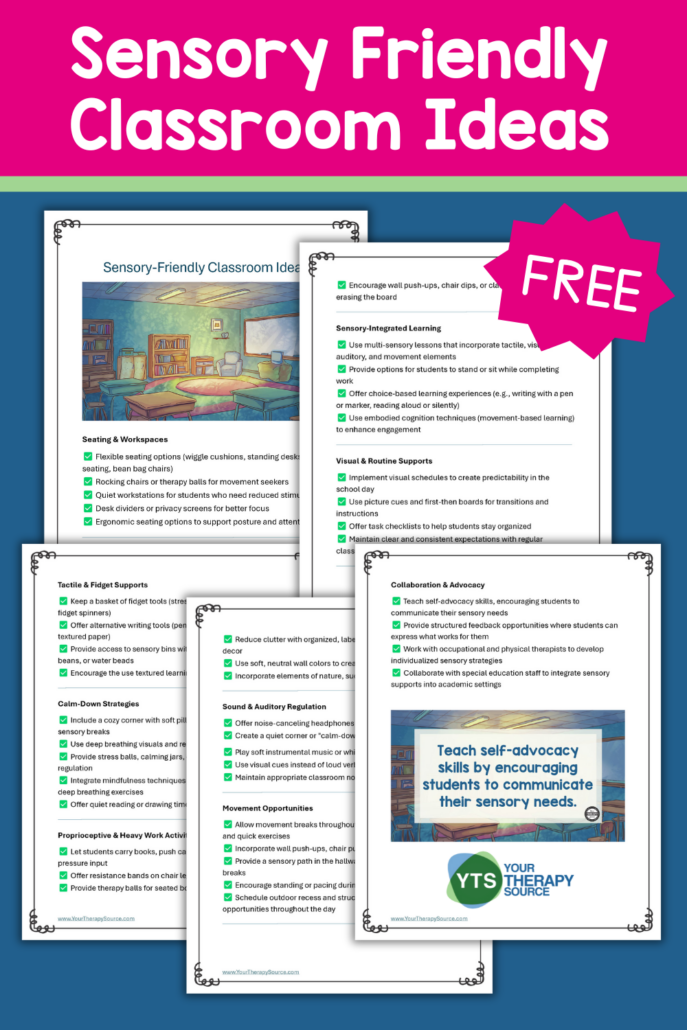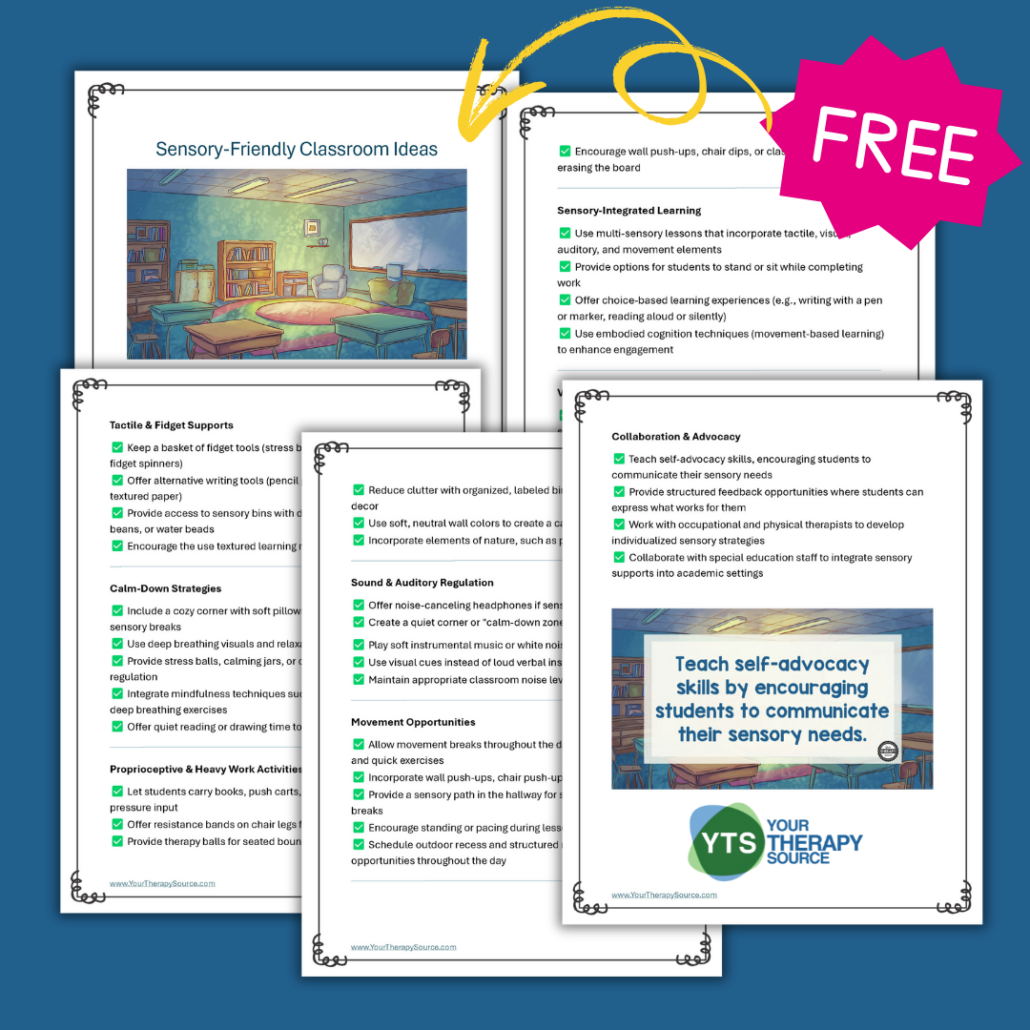Sensory Friendly Classroom Ideas – Free Printable Handout
Creating a sensory friendly classroom helps all students succeed by supporting self-regulation, focus, and emotional well-being. Whether students have sensory processing challenges or simply benefit from structured movement and environmental supports, small changes in the classroom can lead to big improvements in engagement and learning.
To help educators, therapists, and school staff, we’re offering a free printable handout packed with easy-to-implement strategies for making your classroom a more sensory-supportive space. If you are unsure which strategies are best for your students, use your professional judgment or consult with your school-based occupational or physical therapist for recommendations tailored to your classroom.

Benefits of a Sensory Friendly Classroom
A sensory-friendly classroom creates an inclusive environment where all students feel comfortable, engaged, and ready to learn. Some key benefits include:
- Improved self-regulation – Providing sensory-friendly supports helps students manage emotions, energy levels, and focus.
- Increased attention and participation – When sensory needs are met, students can engage more fully in learning activities.
- Reduced classroom disruptions – Meeting sensory needs proactively can help prevent meltdowns, fidgeting, or off-task behaviors.
- Support for diverse learning styles – Sensory-friendly strategies help all students, including those with autism, ADHD, anxiety, or sensory processing differences.
- Better transitions and routines – Visual supports and movement breaks make classroom routines easier for students to follow.
Tier One Interventions for a Sensory-Friendly Classroom
These strategies can be used at the whole-class level to support all students, with opportunities for individualization when needed.
Seating & Workspaces
- Flexible seating options such as wiggle cushions, standing desks, floor seating, or bean bag chairs
- Rocking chairs or therapy balls for students who need movement
- Quiet workstations for students who need reduced stimulation
- Desk dividers or privacy screens to help with focus
- Ergonomic seating options to support posture and comfort
Lighting & Visuals
- Use natural lighting or warm lamps instead of fluorescent lights
- Provide sunglasses or visors for light-sensitive students
- Reduce clutter with organized, labeled bins and minimal wall decor
- Use soft, neutral wall colors to create a calming space
- Incorporate elements of nature, such as plants or aquariums
Sound & Auditory Regulation
- Offer noise-canceling headphones for students sensitive to sound
- Create a quiet corner or “calm-down zone” with comfortable seating
- Play soft instrumental music or white noise in the background
- Use visual cues instead of loud verbal instructions
- Maintain appropriate classroom noise levels with a noise meter
Movement Opportunities
- Allow movement breaks throughout the day, including stretching and quick exercises
- Incorporate wall push-ups, chair push-ups, or yoga poses
- Provide a sensory path in the hallway for structured movement breaks
- Encourage standing or pacing during lessons when appropriate
- Schedule outdoor recess and structured movement opportunities throughout the day
Tactile & Fidget Supports
- Keep a basket of fidget tools such as stress balls, textured rings, putty, or fidget spinners
- Offer alternative writing tools like pencil grips, weighted pencils, or textured paper
- Provide access to sensory bins with different textures such as rice, beans, or water beads
- Encourage the use of textured learning materials
Calm-Down Strategies
- Include a cozy corner with soft pillows or bean bag chairs for sensory breaks
- Use deep breathing visuals and relaxation guides
- Provide stress balls, calming jars, or other quiet fidgets for self-regulation
- Integrate mindfulness techniques such as guided imagery or deep breathing exercises
- Offer quiet reading or drawing time to help students reset
Proprioceptive & Heavy Work Activities
- Let students carry books, push carts, or stack chairs for deep pressure input
- Offer resistance bands on chair legs for leg movement
- Provide therapy balls for seated bouncing or stretching
- Encourage wall push-ups, chair dips, or classroom chores like erasing the board
Sensory-Integrated Learning
- Use multi-sensory lessons that incorporate tactile, visual, auditory, and movement elements
- Provide options for students to stand or sit while completing work
- Offer choice-based learning experiences such as writing with a pen or marker, reading aloud or silently
- Use embodied cognition techniques (movement-based learning) to enhance engagement
Visual & Routine Supports
- Implement visual schedules to create predictability in the school day
- Use picture cues and first-then boards for transitions and instructions
- Offer task checklists to help students stay organized
- Maintain clear and consistent expectations with regular classroom rule reviews
Collaboration & Advocacy
- Teach self-advocacy skills, encouraging students to communicate their sensory needs
- Provide structured feedback opportunities where students can express what works for them
- Work with occupational and physical therapists to develop individualized sensory strategies
- Collaborate with special education staff to integrate sensory supports into academic settings
Who Should Use These Suggestions?
Any classroom teacher can incorporate sensory-friendly strategies, but not every suggestion will be appropriate for every classroom.
- General education teachers may use strategies such as movement breaks, flexible seating, and visual supports to help all students succeed.
- Special education teachers may incorporate fidget supports, proprioceptive activities, and individualized sensory plans for students with higher sensory needs.
- Therapists and support staff can collaborate with teachers to implement specific sensory strategies for individual students or groups.
Reminder: If you are unsure which strategies are best for your students, use your professional judgment or consult with your school-based occupational or physical therapist for recommendations tailored to your classroom.
More Helpful Resources
Looking for more guidance on sensory integration in schools? Check out these resources:
- Sensory Integration at School
- MTSS and Sensory Processing Challenges
- 10 Sensory Integration Activities You Can Try Right Now
- Sensory Classroom Ideas for ALL Students
Download Your Free Printable Handout
Ready to create a more sensory-friendly classroom? Download your free printable handout with all these strategies and get started today! By making small changes, you can create a classroom environment that supports learning, self-regulation, and emotional well-being for all students. Share this post with fellow educators and therapists to help create more inclusive learning environments!



